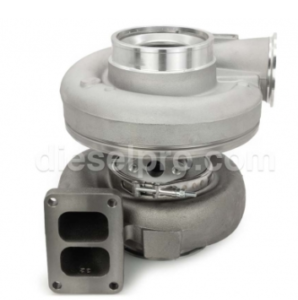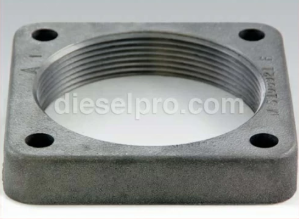
Turbocharger Inspection | Intake Manifold Maintenance
The air intake system in Cummins ISM, ISMe, and QSM11 engines plays a vital role in delivering clean, pressurized air to the combustion chambers, ensuring efficient combustion, fuel economy, and emissions compliance. The turbocharger and intake manifold are critical components of this system, responsible for boosting engine power and optimizing airflow.
A malfunctioning turbocharger or intake manifold can lead to reduced engine performance, increased fuel consumption, loss of power, and excessive exhaust smoke. Proper inspection, maintenance, and troubleshooting are essential to prevent engine damage and extend component life.
This guide provides detailed step-by-step procedures for inspecting the turbocharger, maintaining the intake manifold, diagnosing airflow issues, and ensuring optimal engine efficiency.
For specific boost pressure settings, torque values, and service intervals, consult an OEM service manual or contact Diesel Pro Power for expert assistance.
Parts Catalog for ISM Cummins Marine and Industrial Engines
Turbocharger & Related Components for Cummins ISM engine
Exhaust Manifold & Related Components for Cummins ISM engine
Parts Catalog for QSM Cummins Marine and Industrial Engines
Turbocharger & Related Components for Cummins QSM11 engine
Exhaust Manifold & Related Components for Cummins QSM11 engine
Turbocharger Inspection for Cummins ISM, ISMe, and QSM11

The turbocharger increases engine power and efficiency by compressing intake air before it enters the cylinders, allowing for more complete fuel combustion. A failing turbocharger can cause poor acceleration, excessive smoke, and loss of boost pressure.
Key Components of a Turbocharger
✔ Compressor Wheel – Draws and compresses intake air before sending it into the engine.
✔ Turbine Wheel – Spins using exhaust gases, driving the compressor.
✔ Wastegate or Variable Geometry Vanes – Regulates boost pressure to prevent over-boosting.
✔ Bearing Housing and Oil Seals – Lubricate and cool the rotating assembly.
✔ Intercooler – Cools compressed air before entering the intake manifold.
How the Turbocharger Works
- Exhaust Gases Drive the Turbine Wheel
- The engine’s hot exhaust gases pass through the turbine housing, spinning the turbine wheel.
- The engine’s hot exhaust gases pass through the turbine housing, spinning the turbine wheel.
- The Compressor Wheel Pressurizes Intake Air
- The spinning compressor wheel draws in and compresses intake air, increasing air density and oxygen levels.
- The spinning compressor wheel draws in and compresses intake air, increasing air density and oxygen levels.
- The Intercooler Reduces Air Temperature
- The compressed air flows through the intercooler, which cools it before entering the intake manifold.
- The compressed air flows through the intercooler, which cools it before entering the intake manifold.
- Boost Pressure is Regulated
- A wastegate (or variable vanes in VGT turbos) controls excess boost pressure, preventing damage to the engine.
- A wastegate (or variable vanes in VGT turbos) controls excess boost pressure, preventing damage to the engine.
Common Turbocharger Issues and Symptoms
| Symptom | Possible Cause | Recommended Action |
| Loss of Power | Turbocharger not spinning properly | Inspect bearings, compressor wheel |
| Excessive Black Smoke | Poor air-fuel mixture due to insufficient boost | Check boost pressure, inspect air filter |
| Whining or Grinding Noise | Worn bearings, damaged compressor/turbine | Inspect turbo shaft play, check for oil leaks |
| Excessive Oil Consumption | Leaking oil seals, clogged return lines | Inspect turbo drain system, replace worn seals |
| Overheating Turbo | Lack of lubrication, restricted airflow | Check oil supply, clean intercooler |
Step 1: Inspecting the Turbocharger

- Check for Boost Pressure Leaks
- Connect a boost pressure gauge to measure pressure at full throttle.
- If pressure is lower than specifications, inspect for air leaks.
- Inspect the Compressor and Turbine Wheels
- Remove the intake piping and visually inspect the compressor wheel for damage.
- Check the turbine wheel for cracks, missing blades, or debris buildup.
- Check for Excessive Shaft Play
- Move the turbocharger shaft by hand; it should spin freely without excessive movement.
- If the shaft wobbles or grinds, the bearings may be worn.
- Inspect the Turbocharger Oil Supply and Drain Lines
- Look for oil leaks around the turbo housing.
- Ensure the oil return line is free of blockages.
Step 2: Replacing a Faulty Turbocharger

- Remove the Exhaust and Intake Connections
- Loosen and disconnect the turbocharger from the exhaust manifold and intercooler.
- Loosen and disconnect the turbocharger from the exhaust manifold and intercooler.
- Disconnect the Oil Supply and Drain Lines
- Be careful not to spill oil into the engine bay.
- Be careful not to spill oil into the engine bay.
- Unbolt and Remove the Turbocharger
- Support the turbo while removing mounting bolts to prevent damage.
- Support the turbo while removing mounting bolts to prevent damage.
- Install the New Turbocharger
- Use new gaskets and O-rings to ensure a proper seal.
- Torque mounting bolts to OEM specifications.
- Reconnect Oil and Air Lines, then Prime the Turbo
- Before starting the engine, manually add oil into the turbo bearing housing.
- Before starting the engine, manually add oil into the turbo bearing housing.
- Start the Engine and Check for Leaks
- Let the engine idle for a few minutes to circulate oil through the turbocharger.
- Let the engine idle for a few minutes to circulate oil through the turbocharger.
Intake Manifold Maintenance for Cummins ISM, ISMe, and QSM11

The intake manifold distributes compressed air from the turbocharger evenly to the cylinders. Carbon buildup, cracked gaskets, or clogged passages can restrict airflow, reducing power and increasing fuel consumption.
Key Functions of the Intake Manifold
✔ Evenly distributes air to all cylinders for balanced combustion.
✔ Houses sensors and EGR components for emissions control.
✔ Ensures smooth airflow from the turbocharger into the combustion chambers.
Common Intake Manifold Issues and Symptoms
| Symptom | Possible Cause | Recommended Action |
| Loss of Power | Clogged intake manifold, air leaks | Clean or replace manifold, check for leaks |
| Excessive Soot Deposits | EGR system malfunction | Inspect and clean EGR passages |
| Hissing Noise from Intake | Leaking manifold gasket | Replace gasket, tighten bolts |
| Rough Idle and Misfires | Uneven air distribution | Inspect and clean intake ports |
Step 1: Inspecting the Intake Manifold

- Check for Carbon Buildup and Debris
- Use a borescope to inspect the intake runners and passages.
- If excessive carbon deposits are present, cleaning is required.
- Inspect for Air Leaks at Gaskets and Connections
- Spray soapy water around the manifold while the engine is running.
- If bubbles appear, the manifold is leaking air.
- Check Sensors and EGR Connections
- Ensure the EGR valve is functioning correctly and not clogged with soot.
- Inspect intake air temperature and pressure sensors for contamination.
Step 2: Cleaning and Replacing the Intake Manifold

- Disconnect the Intake Piping and Sensors
- Label and remove electrical connectors and vacuum lines.
- Label and remove electrical connectors and vacuum lines.
- Unbolt and Remove the Intake Manifold
- Loosen mounting bolts in sequence to prevent warping.
- Loosen mounting bolts in sequence to prevent warping.
- Clean the Intake Manifold Thoroughly
- Use a professional intake manifold cleaner or ultrasonic cleaning for best results.
- Scrub passages with a brush to remove stubborn carbon buildup.
- Inspect the Gasket Surface for Damage
- If the mating surface is uneven, resurface or replace the manifold.
- If the mating surface is uneven, resurface or replace the manifold.
- Install the New or Cleaned Intake Manifold
- Use new gaskets and torque bolts to OEM specifications.
- Use new gaskets and torque bolts to OEM specifications.
- Reconnect Sensors and Piping, then Test for Leaks
- Perform a boost pressure test to ensure a proper seal.
- Perform a boost pressure test to ensure a proper seal.
Final Notes on Air Intake System Maintenance for Cummins ISM, ISMe, and QSM11
✔ Inspect turbochargers regularly for shaft wear and oil leaks.
✔ Clean or replace clogged intake manifolds to restore airflow.
✔ Check all gaskets and connections for air leaks.
✔ Perform routine maintenance to maximize fuel efficiency and engine performance.
✔ Consult Diesel Pro Power for expert guidance and high-quality replacement parts.
By following these detailed procedures, you can ensure optimal turbocharger performance, improved fuel economy, and extended engine life for Cummins ISM, ISMe, and QSM11 engines.
Parts Catalog for ISM Cummins Marine and Industrial Engines
Turbocharger & Related Components for Cummins ISM engine
Exhaust Manifold & Related Components for Cummins ISM engine
Parts Catalog for QSM Cummins Marine and Industrial Engines
Turbocharger & Related Components for Cummins QSM engine
Exhaust Manifold & Related Components for Cummins QSM engine



 Free US Calls: 1-888-433-4735
Free US Calls: 1-888-433-4735 International: 305-545-5588
International: 305-545-5588